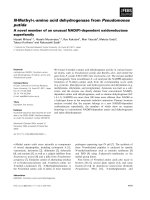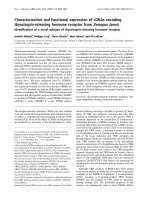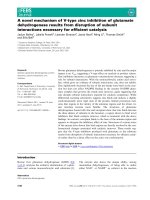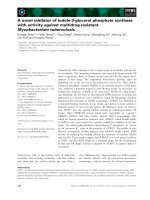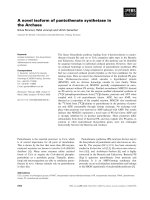A novel solution of QoS routing with multi constraint algorithm
Bạn đang xem bản rút gọn của tài liệu. Xem và tải ngay bản đầy đủ của tài liệu tại đây (478.2 KB, 10 trang )
Electronics and Automation
A NOVEL SOLUTION OF QoS ROUTING WITH
MULTI-CONSTRAINT ALGORITHM
Tran Minh Anh1,*, Nguyen Chien Trinh1, BuiThi Minh Tu2
Abstract: In providing new telecommunication (telecom) services, the requisition
for quality of network is more and more popular and sophisticated with high
bandwidth, small value of delay time or packet loss etc. To assure the quality of
network, the scheme of Quality of Service (QoS) routing algorithm based on local
state information have recently been researched as a promising alternative to the
currently deployed global QoS routing schemes. Different from the traditional QoS
routing algorithms that use global state information, the localized routing
algorithms use local information collected from source node to make routing
decisions. These localized routing algorithms can be a solution to meet the demand
of telecom market in the near future.In this paper, we introduce a new localized
QoS routing algorithm that uses bandwidth and delay as constraints; and research
the impacts of QoS routing algorithms on the network bandwidth balancing through
a proposed parameter of evaluating network bandwidth disparity. We also perform
our algorithm with experiments, compare and realize the more considerable
performance of this algorithm than other algorithms wherein we use the same type
of network topology, QoS requirements and traffic patterns.
Keywords:Algorithm, Balancing, Bandwidth, Delay, Localized.
1. INTRODUCTION
Nowadays, telecom network develops very strongly and the guarantee of quality for
large-scale networks becomes much challenged. Therefore, the approach of using local
information to make routing decisions is an effective way of communicating in network.
Due to using local information, this routing technique will decrease the average overall
blocking probability of packets transmitted through the network, and hence makes the
overall performance of network better than global QoS routing schemes that update
network state periodically by a link-state algorithm and maintain it up-to-date. The way
that global QoS routing schemes do will lead to a large communication overhead, the
inexact of global state and the out-of-date information due to large update
intervals.Localized QoS routing helps to avoid these problems by routing based on local
information. By this approach, each node maintains a predetermined set of candidate paths
to each possible destination and routes flow along these paths. This will help network run
more effectively.
In this paper, we propose a new localized QoS routing which uses bandwidth and delay
as constraints for routing, and analyze the network bandwidth balancing with this
algorithm through simulations witha proposed parameter of evaluating network bandwidth
disparity. We compare and realize better performance against some other localized routing
algorithms when we perform simulations with the same types of topology, traffic patterns
and under the same range of traffic loads.
The rest of the paper is structured as follows. Section 2 surveys some QoS routing
schemes as related works. Section 3studies a parameter ofevaluating network bandwidth
disparity,researches the impacts of QoS routing on network bandwidth balancing; and
describes our novel routing algorithm. Section 4 studies the performances of simulations
that show the more favourable results of our routing algorithm. In the end, section 5
concludes the paper and proposes the next works.
58
T.M.Anh,N.C.Trinh, B.T.M.Tu, “A novel solution of QoSrounting…”
Research
2. RELATED WORKS
The parameters of QoS like bandwidth, delay … have been used to estimate the quality
of transmission for telecom services in some years recently and there are a lot of
researches for QoS routing which have been published on many different areas as [1-2]. In
the future, when the convergence of services becomes stronger, QoS routing will be more
important. As explained in the previous sections, localized QoS routing algorithm has been
proposed recently as a viable alternative to global QoS routing.
In localized routing algorithm, nodes firstly build the set of candidate paths between all
pair of nodes from itself. It maintains this set and makes routing decisions by using only
local state information collected at that node. Therefore, no global-state information needs
to be exchanged, then ithelps to reduce the overhead computation, and helps routing better.
To expose some advanced points above, we now survey some localized QoS routing
schemes as follows.
The first scheme we mention is the localized Credit Based Routing algorithm (CBR) as
in [3]. The CBR uses a simple routing procedure to route traffic across the network by
using crediting scheme for each candidate path that rewards a path upon flow acceptance
and penalizes it upon flow rejection. The CBR algorithm keeps updating each path's credit
upon flow acceptance and. It is also keeps monitoring the flow blocking probabilities for
each path and conveys the data to the credit scheme to select path.
The CBR predetermines a set of candidate paths R between each pair of source and
destination where R = R
∪ R (Rmin: a minimum hop set and Ralt: an alternative paths
set). The CBR selects the largest credit path P.credits in each set, minimum hop (minhop)
paths set Rmin and alternative paths set Ralt upon flow arrival. The flow is routed along the
minimum hop path that has the largest credit Pmin that is larger than the alternative path
that has the largest credits Palt following the formula (1):
P
. Credits ≥ Ф x P . Credits , where Ф≤ 1
(1)
Otherwise, Palt will be chosen. The CBR uses the parameter Ф as a system parameter
that controls the usage of alternative paths. The CBR also uses blocking probability in
crediting schemes to improve the performance of the algorithm. The path credits are
incremented or decremented upon flow acceptance or rejection using statistics of the path
blocking probability. Besides, the CBR uses a MAX_CREDITS system parameter to
determine the maximum attainable credits for each path by computing the blocking
probability.
0 ≤ P. Credits ≤ MAX_CREDITS
(2)
The CBR algorithm records rejection and acceptance for each path and uses a moving
window for a predetermined period of M connection requests. It uses 1 for flow
acceptance and 0 for flow rejection, dividing the number of 0's by M to calculate each path
blocking probability for the period of M connection requests. The main problem with CBR
is that a path’s credits are only updated each time that path is selected. If a path is selected
infrequently, then its credit value will become stale leading to errors in the selection
process.
Another scheme of QoS Routing using local information is the scheme of Highest
Minimum Bandwidth routing algorithm (HMB), see [4]. The HMB algorithm also requires
every node in the network to predetermine and maintain a set of candidate paths between
all pairs of source and destination node. Then, each path will be associated with a variable
Journal of Military Science and Technology, Special Issue, No. 48A, 5 - 2017
59
Electronics and Automation
that is the minimum residual bandwidth (minResBw) link in that path. This value is taken,
compared with the one of other paths among the set candidate paths.
After the comparison, the HMB will choose the best path that has the largest residual
bandwidth among the paths. Then, the HMB will route the flow-in through the selected
path.As well as other localized algorithm, in the HMB algorithm, a predefined set of
candidate paths R must be required and maintained first. However, in the HMB, the
difference is that the algorithm must specify the highest value of minResBw among
candidate path set. The minResBw link of selected path will have preference that will help
itself to be reselected next time. With the comparison like that, HMB requires to collect all
of residual bandwidth of all paths to each destination. This will lead to a high latency if
there are a lot of long paths between that pair.
CBR and HBM are quite simple and they have the good performances as described in
the references [3-4], so we choose them to compare with our proposed algorithm through
simulations in which we use the same patterns of experiments and collect results. We also
choose the traditional global QoS routing algorithm (WSP) in some simulations as well.
The results of simulations will be showed in the section 4.
3. A NEW QoS ROUTING ALGORITHM AND NETWORK BANDWIDTH
BALANCING EVALUATION
3.1. QoSrouting and network bandwidth balance evaluation
QoS routing is gradually becoming an essential part of today’s data networks as many
applications rely on QoS routing to provide the promised quality services. QoS routing
uses network state information and resource availability in addition to the QoS
requirements to meet such demands. QoS routing algorithms that select paths with
sufficient residual resources to meet the QoS constraints have played a critical role in
meeting the required service level. In addition, that, QoS routing algorithms should also
compromise between resource utilization and network traffic balancing to achieve high
routing performance.
To evaluate the network balance, there are many ways as in [5-7]. In this paper, we can
build the formula to evaluate the bandwidth balancing in the network. This formula is
derived from the value of evaluation of differential bandwidth in all links of network. To
count the “differential bandwidth” value, it is required for us to collect the residual
bandwidth of all links in the network. With these data, we build the connection matrix
{mrBrij} of all the paths available for data in that network as follows:
mrBRij 1
2
.. N
Qj
1
0
mrBw21
..
mrBwN1
mrBw
2
mrBw12
0
..
mrBwN2
mrBw
..
..
..
..
..
N
mrBw1N
mrBw2N
..
0
..
mrBw
Where:mrBwijis the minimum residual bandwidth of links in the path that has the
largest residual bandwidth among the set of candidate paths between the two nodes i and j
in the network; N is the number of nodes in network.
60
T.M.Anh,N.C.Trinh, B.T.M.Tu, “A novel solution of QoSrounting…”
Research
From this matrix, we calculate the value of differential bandwidth (value of DB) as the
formula below:
∑
ValueofDB =
( − )
−
∑
−
(3)
Where:
Q = ∑
=
mrBw
∑
(
− )
(4)
(5)
The value (3) can be named as “Value of DB” or VDB. It expresses the differential
usable bandwidth in the network. The routing algorithm is more effective when it makes
the network less differential. It means that if the network using routing algorithm A has
lower value of VDB (less differential in bandwidth) than that network using routing
algorithm B, we can conclude that the algorithmA routes flows more effectively than the
other does. That is becausethe routing algorithm A makes network less disparity of
residual bandwidth than the other.
Therefore, the smaller this value of VDB is, the more effective the network is.
We will use this metric to evaluate the effectiveness of routing algorithms as well as the
impacts of routing algorithm on the bandwidth balance of network in the section 4.
3.2. Description of the proposed algorithm
The QoS requirement of a flow is given as a set of constraints that the routing algorithm
should meet to find out a feasible path. A QoS routing algorithm usually uses one or more
types of metrics to be the constraints for path selection. In the QoS metrics, bandwidth and
delay time are currently the most significant QoS performance metrics for customers’
services. Hence, we use Bandwidth and Delay time as criteria in our scheme, and call our
scheme as Bandwidth-delay-Constraint QoS Routing Algorithm or BQRA.
Like other localized routing algorithms, our algorithm (BQRA) also requires every node
to maintain a predetermined set of candidate paths R to each possible destination.
Moreover, every path PR associated with a variable P.Quality=P.[Bandwidth,Delay] and
an index of that path which called βi. Call Bi as the number of flows blocked on that path
and Ti as the number of flows used by that path. We reckon: βi = (1-Bi/Ti). To choose path,
the set R (all of candidate paths) will be ranged for the value βi.
Upon flow arrival, BQRA selects the path P with maximum value of βior max(βi),
checks the demand of the flow from SLA (Service Level Agreement) and uses it for
choosing path. In the algorithm of BQRA, we call that demand as SLA.[Bandwidth,Delay]
or SLA. If there is not any QoS requirement from flow, it will choose the path P to route.
Otherwise, it compares P. Quality and SLA (the demand). From the comparison between
P.Quality and SLA, we have some cases:
If P.Quality ≥ SLA, path P will be chosen and BQRA send the flow-in through path P.
If P.Quality< SLA, BQRA selects the next P in the R (the max βi of the rest of R).
The loop will be done until finding out the path has maximum value of βi and
P.Quality≥SLA. (The way to compare will be discussed in part of 3.5).
Journal of Military Science and Technology, Special Issue, No. 48A, 5 - 2017
61
Electronics and Automation
If in the set R, there is not any path that has P.Quality larger than SLA, the arriving
flow obviously is cancelled. In that case, the index Ti, and Bi will increase.
When transmitting successfully a flow to destination node, only value of Ti increases.
The index βi is a value for evaluating the path. When the path P is selected and
P.Quality is greater than the value of requested quality (SLA), this indicates that the
candidate path has good quality, and the path will be ready to transmit that flow. The value
of Ti of that path increases, that leads to the increment of βi. After that, the following flow
will use this index βi to be criterion to choose path, and next loop re-begins. Therefore,
after one flow processed, βi changes accordingly to the capacity of that path and
probability of that path changed correspondingly. Due to the fact that the distribution of
network resource is based on probability of successful transmitting of flows in network,
BQRA itself affects to the balancing of network as well.
3.3. The flowchart of BQRA
From the steps described in the previous part, we can study the flowchart as follows:
Figure 1. The BQRA flowchart.
3.4. The complexity and overhead
The overhead of global QoS routing can be attributed to two factors: The computation
complexity required to find feasible paths and the excessive signaling overhead resulting
from network state information exchange. And as analyzed in [2], the scheme of global
QoS routing algorithm like WSP which uses Dijikstra algorithm takes at least
O(NlogN+L) time, where N is the number of nodes, and L is the number of links from that
network.
At the same time, the localized schemes such as CBR, HMB or BQRA use the way of
routing that selects path from the pre-determined set of candidate paths R, with the size of
R is |R|. The path selection is an invocation of a weighted-round-robin like path selector
(wrrps), whose worst-case time complexity is O(|R|), as in [6]. In addition, these localized
62
T.M.Anh,N.C.Trinh, B.T.M.Tu, “A novel solution of QoSrounting…”
Research
schemes require updating information, which takes a constant time O(1). Hence, with
communication overhead, BQRA or other localized schemes requires very little over and
above computing the blocking probability based on acceptance or rejection of a path,
while at the same time, global algorithms require a huge amount of overhead to keep the
link state information updated. In conclusion, the computation of our case at source node
anyway is much smaller than the one of traditional WSP cases.
3.5. The metric selection and comparison
We can make the comparison of the two metrics (Bandwidth and Delay) successively.
Firstly, we compare the bandwidth of the path with the demanded bandwidth of flow.
Then, we continue to compare the value of Delay between path and flow.
The path is only chosen when we have two values of true for two comparisons.
Note: We compare P.Bandwidth ≥ F.Bandwidth and P.Delay ≤ F.Delay, where
Bandwidth is the minimum residual bandwidth of any link on path and Delay is the sum of
all delay of propagation from all links on this path.
The procedure is as follows:
PROCEDURE Compare(p,f)
If p.Bandwidth ≥ f.Bandwidth
If p.Delay ≤ f.Delay
p is chosen
Else
p is discarded
Else
p is discarded
Figure 2.Comparison between two constraints bandwidth and delay.
4. PERFORMANCE EVALUATION
In this section, we realize the performance of the BQRA scheme and compare it with
the CBR, HMB and the global QoS routing scheme widest shortest path (WSP). All the
experiments will be set in the same condition. Next, we analyze the results of our
simulation model and performance metrics of these schemes.
4.1. Simulation Model
Using the popular simulator OMNeT++ 4.5 in [10], we simulate a network with 18
nodes and 108 links. Links between these nodes are all bidirectional with the capacity C =
20Mbps in each direction and the same value of delay D = 20ms. Flows arrive to each
source node according to a Poisson process with rate λ and destination nodes are selected
randomly (each node can be source or destination). Flow duration is exponentially
distributed with mean Bandwidth of flows is uniformly distributed within [15MBytes], and the required value set for Delay of each flow is randomly distributed
between 20ms and 250ms. Network is performed in Figure 3.
As analyzed in [8-9], the offered network load is:
bh/LC
(6)
where N is the number of nodes, b is the average bandwidth required by a flow, h is the
average path length (in number of hops) and L is the number of links in the network. In the
experiments, we set N=18, L=60, h=2.36, 1/= 60s.
Since the performance of routing algorithms may vary across different load conditions,
Journal of Military Science and Technology, Special Issue, No. 48A, 5 - 2017
63
Electronics and Automation
our simulation experiments consider several types of different load conditions through the
value of λ according to experiments of from low loads to high loads.
Figure 3. Network of 18 nodes.
4.2. Evaluation Parameters
To compare with other schemes, we choose flow blocking probability as criteria as well
as the simulation in [3-4]. The blocking probabilities are calculated based on the most
recent 100,000 flows. The time of simulation is set about of 20 minutes, with more than
2.5 million of flows emitted. We take the ratio as follows:
Flow Blocking Probability = |B|/|T|
(7)
Where: |T| is the total of all flows, |B| is total of blocked flows.
We also calculate the overall end-to-end delay of network when we run the scheme
BQRA and the scheme of WSP with different load. Next, as introduced in the part 3.1, we
collect the values of residual bandwidth from the network, and calculate the values of DB
(VDB) of the network as the formula (3). From these values, we can analyze the impacts
ofthe routing algorithms on the performance of that network.
4.3. Simulation Results
With the results of performances collected from the simulation, we compare among
schemes, as shown in some figures below.
Figure 4. Flow Blocking Probability.
Figure 4 shows the performance of BQRA against CBR, HMB and WSP in terms of
flow blocking probability under load varies from 0.2 to 0.5. From these values, we see
that under low load ( ≤ 0.25), the difference in the performance of the routing algorithms
is quite small, because finding available path with sufficient bandwidth is easy and flows
are almost accepted.When is high (more than 0.3), there are some differences as showed
64
T.M.Anh,N.C.Trinh, B.T.M.Tu, “A novel solution of QoSrounting…”
Research
above. Many flows drop or fail to get destination node, then flow blocking probability
grows rapidly as showed in Figure 4.
Moreover, the setting index for choosing path helps to avoid the congestion of flows
come at nodes simultaneously, particularly when the load increases and the links begins to
become congested. If congestion happens, flows will be redirected to other path and the
index decreases at once. Then, the source node might reduce the using of these paths,
which have low index. Therefore, the probability of flow blocking is considerably low
against the case of CBR, HMB and WSP as well.
From the Figure 5, we can see that when the number of flows increases, the Average
End-to-End Delay will keep a stable value and the BQRA expresses the more efficiently.
The margin between two cases is slightly low at = 0.2, but when the load = 0.5, it
becomes higher as showed below.
It means that with high load, the congestion happens more frequently, so, this value is
higher. In our case, the BQRA changes path more frequently based on the index βi. When
congestion happens, the index of the candidate path diminishes, then, our case changes
path. Therefore, the average End-to-End Delay is better than case of WSP as well.
Figure 5. Average End-to-End Delay of flows when =0.2 and 0.5.
Next, with the parameters of residual bandwidth of every link, we can calculate the
VDB of network at each value of the load (from 0.2 to 0.5). And the results is showed in
the Figure 6.
Figure 6. The values of DB when varies from 0.2 to 0.5.
From that, we can see that with high , the difference of bandwidth becomes higher.
The disparity of bandwidth among links is more, and therefore it makes the VDB of
network higher. With the disparity of the bandwidth of links in the network is smaller, the
scheme BQRA shows that it makes the bandwidth balancing smoother and more flexible.
The reason is that with high load, the congestion happens more frequently, so this VDB
increases, especially in the WSP case. In our case, the flows will change path frequently
Journal of Military Science and Technology, Special Issue, No. 48A, 5 - 2017
65
Electronics and Automation
based on the index βi. Hence, it makes the bandwidth usage more equally, and the VDB is
little smaller than any scheme else.
In concluding, the case of BQRA has better performance than other cases such as CBR,
HMB or WSP in the experiments that have been done.
5. CONCLUSION AND ONGOING WORK
In this paper, we proposed a new localized QoS routing algorithm to choose path using
only flow information collected locally at source node. We have done many experiments
to compare the performance among BQRA, CBR, HMB and WSP algorithms. These
experiments have already showed a better performance of BQRA with better time
complexity and very low communication overhead. We collect the local information of
blocking probability to update the path index. This index directly decides the routing,
hence makes better quality of routing, on the other hand, better working of network.
As part of future work, we will investigate the effect of using more QoS parameters to
computation at nodes. From that, we will adjust the algorithm to make routing more
flexible. Finally, as proposed in the paper, we will care for the way of building sets of
candidate paths, based on knowledge of network as well as reduction of computing at
nodes. In the future network, with the more sophisticated selection of set of paths, the
algorithm will operate more effectively and more reliably.
REFERENCES
[1]. C. Pornavalai, G. Chakraborty, N. Shiratori, "QoS based routing algorithm in
integrated services packet networks", Proceedings of the IEEE ICNP, 1997.
[2]. R. Guerin, S. Kamat, A. Orda, T. Przygienda, D. Williams, “QoS Routing
Mechanisms and OSPF Extensions”, Work in Progress, Internet Draft, March 1997.
[3]. S. Alabbad, M. E. Woodward. “Localized Credit Based Routing: Performance
Evaluation Using Simulation", Proc. of IEEE 39th Annual Simulation Symposium,
Huntsville, Al. USA April 2-6 2006.
[4]. T. A. Al Ghamdi and M. E. Woodward, "Novel localized QoS routing algorithms," in
Proc. IEEE 9th Malaysia International Conference on Communications, Kuala
Lumpur, Malaysia, Dec. 2009, pp. 199-204.
[5]. A. Gonzlez-Ruiz and Y. Mostofi, “Distributed load balancing overdirected network
topologies,” in Proc. ACC 09 , St. Louis, Missouri,USA, 2009.
[6]. Yaling Yang, Jun Wang, Robin Kravets, “MobiCom Poster Abstract: Load-balanced
Routing For Mesh Network”, Mobile Computing and Communications Review,
Volume 10, No. 4.
[7]. Tran Minh Anh, Nguyen Chien Trinh, “Propose a Metric to Evaluate Network
Quality”, in Proceedings of the 06th International Conference on Electronics,
Information, and Communication (ICCE 2016), pp. 493-503, Jul. 2016, Halong,
Vietnam.
[8]. A. Shaikh, J. Rexford, K. Shin, “Load-Sensitive Routing of Long-Lived IP Flows”,
ACM SIGCOMM 1999.
[9]. A.Shaikh, J.Rexford, K.G.Shin, “Efficient Precomputation of Quality-of-Service
Routes”. Proc. IEEE NOSSDAV 98, July, 1998.
[10].A. Varga, “The OMNeT++ Discrete Event Simulation System”, the European
Simulation Multiconference, Prague, Czech Republic, 2001.
66
T.M.Anh,N.C.Trinh, B.T.M.Tu, “A novel solution of QoSrounting…”
Research
TÓM TẮT
GIẢI PHÁP ĐỊNH TUYẾN ĐẢM BẢO QoS MỚI VỚI
THUẬT TOÁN ĐỊNH TUYẾN ĐA RÀNG BUỘC
Trongquátrìnhcungcấpdịchvụviễnthôngmớihiện
nay,
yêucầuvềchấtlượngmạnglướingàycàngtrởnênphổbiếnvàphứctạpvớibăngthôngcao,
giátrịđộtrễ,
độmấtgóinhỏ.
Đểđảmbảochochấtlượngmạnglưới,
kiểuthuậttoánđịnhtuyếnđảmbảoQoSchỉsửdụngthông
tin
tạinộibộnútđểđịnhtuyếnthông
tin
đãvàđangđượcnghiêncứunhiềuhiện
nay,
nhưlàmộtgiảiphápbổtrợquantrọngchocáckiểuthuậttoánđảmbảoQoStruyềnthống.
KhácvớikiểuđịnhtuyếnđảmbảoQoStruyềnthốngdùngthông
tin
toànmạngđểchọnđường, thuậttoánđịnhtuyếndùngthông tin nộibộchỉdựavàothông tin
thunhặttạinộibộnútđểđưaraquyếtđịnhchọnđường.
Kiểuthuậttoánnàyhứahẹnlàmộtgiảiphápchoviệcđápứngnhucầucủathịtrườngviễnthôn
gtrongtươnglai.BàibáonàygiớithiệumộtthuậttoánđịnhtuyếnđảmbảoQoSdùngthông
tin
nộibộmớisửdụngbăngthôngvàđộtrễlàmhairàngbuộc;
nghiêncứuảnhhưởngcủacácthuậttoánđịnhtuyếnđảmbảoQoSlênviệccânbằngbăngthô
ngmạng
qua
mộthệsốđánhgiáđộchênhlệchbăngthôngđượcđềxuấttrongbàibáo.
Cácthínghiệmmôphỏngthựchiệngiữathuậttoánđềxuấtvàcácthuậttoánliênquankhácvớ
icácmôitrườngthínghiệmtươngtự.
Qua
kếtquảmôphỏng,
bàibáochothấyhiệuquảtốthơncủagiảithuậtđềxuất.
Từ khóa: Giải thuật, Cân bằng, Nội bộ, Băng thông, Độ trễ.
Received date, 16th January 2017
Revised manuscript, 29th March 2017
Published on 26th April 2017
Author affiliations:
1
Posts and Telecommunications Institute of Technology, Hanoi City, Vietnam
2
University of Science and Technology, University of Danang, Vietnam
*Correspondingauthor:
Journal of Military Science and Technology, Special Issue, No. 48A, 5 - 2017
67


